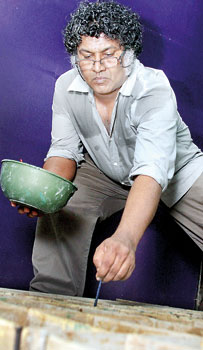Space to ‘say’ something not so beautiful
As the opening of Chandraguptha Thenuwara’s latest exhibition draws near, he seems to relish the thought of putting his viewers to work. “When you enter the exhibition you won’t see many paintings,” says the artist. “You’ll have to find them.” It’s a clever twist on his theme, ‘Beautification’. The space made clean and pristine, so that it is near sterile; all memory, all culture scrubbed out so that the past is no longer concrete. Only the truly determined will find its traces, perhaps under their feet or blending into the walls. “I’m taking on the beautification of the Lionel Wendt gallery space,” says the artist.

Chandragupta Thenuwara: A close brush with politics. Pic by Indika Handuwala
This exhibition is the latest in a series that began in 1998. The chairperson and founder of the Vibhavi Academy of Fine Arts, Thenuwara has ‘commemorated the uncommemoratable’ annually, using his exhibition to encourage dialogue and acknowledgement of the events of Black July. To ensure each exhibition is simultaneously current, Thenuwara says he takes a good look around him yet keeps his focus centred on ethnic issues. He feels keenly the need to talk less and do more about reconciliation, to challenge the “camouflaged mind”.
Fierce and outspoken, Thenuwara finds room in art to express his concerns and makes full use of it. “The exhibition space is still an untouched area by the politicians,” he says, “they think it’s not an active space…that a gallery space is where you only show the beautiful things. I am using that space to show my work with these messages.” He feels art actually multiplies the potency of what he wants to communicate. Whether people agree or disagree with what he has to say is not the point, the point is they came and were engaged. In his art, his politics are made tangible: “if you care very consciously about your social ethos and want to intervene in society and change it, you can do it through visual art,” says the artist. He wonders how long it will remain uncensored, but regardless of the concern his friends and admirers have expressed for his wellbeing, Thenuwara says he will not self-censor.
His resolve to remember is born of having seen for himself the horrors of ’83 on the streets of Colombo. “It happened in front of me,” he says. “I saw the burning and looting and the mobs.” Still in his early twenties, he felt none of them could do anything to stop the unravelling violence. Two years later he left for Russia to undertake his higher studies. He wouldn’t return till well into the next decade and when he did it was to find a different political landscape – this one marked by talk of political reconciliation and ceasefires. However, with the checkpoints that sprang up, Thenuwara had found a new motif to incorporate into his art.
“The barrel is not an innocent object – there’s power, presence, a lot of blood hidden in the barrel,” he says. ‘Barrelism’ soon became established, its creator having used it so adroitly to explore a range of ideas including how society collaborated so willingly in its own subjugation. “Why when someone is blocking our space, are we not questioning it?” Thenuwara asks. As the war progressed to its conclusion, Thenuwara found another compelling visual element – barbed wire – which had become fraught with meaning thanks to its use in the war zone and the IDP camps. In a time where civil society knew so little about what was going on, Thenuwara says “again this barbed wire became a kind a symbol for ethnic issue.”Thenuwara went on to explore camouflage – moving it from his barrels to large canvases and successfully subverting the striking combination of brown, green and yellow on military uniforms.
Now Thenuwara will be incorporating it all into another exhibition of drawings, sculptural elements and installations. He seeks to explore some of the contradictions inherent in the process of beautification which he sees as a “superficial response” that creates “dehumanised spaces.”Questioning these changes is critical, “otherwise we won’t really go forward,” he says, adding, “beautification is the new camouflage.”
The changes in Colombo have made him feel like he is no longer a part of the city, that only certain groups can claim the right to feel at ease in these new spaces. For all that it’s a beautified space, he’d like his exhibition to be more inclusive. “I think the participation is very important,” he says, “[At my exhibition] you cannot be a passive viewer, you can enjoy or reject it, but that participation is crucial.”
Follow @timesonlinelk
comments powered by Disqus


